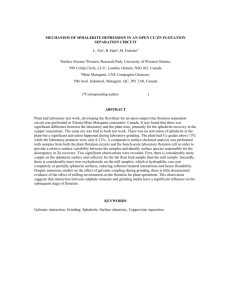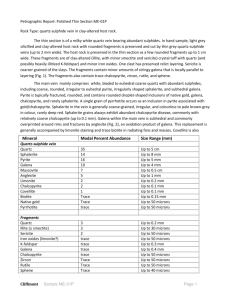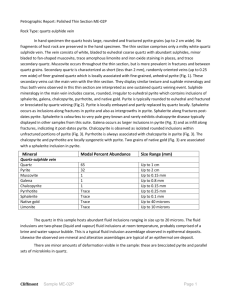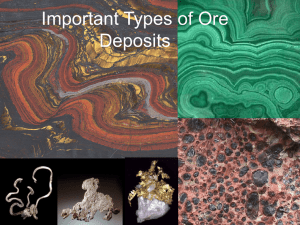Sphalerite as a matrix for noble, non
advertisement
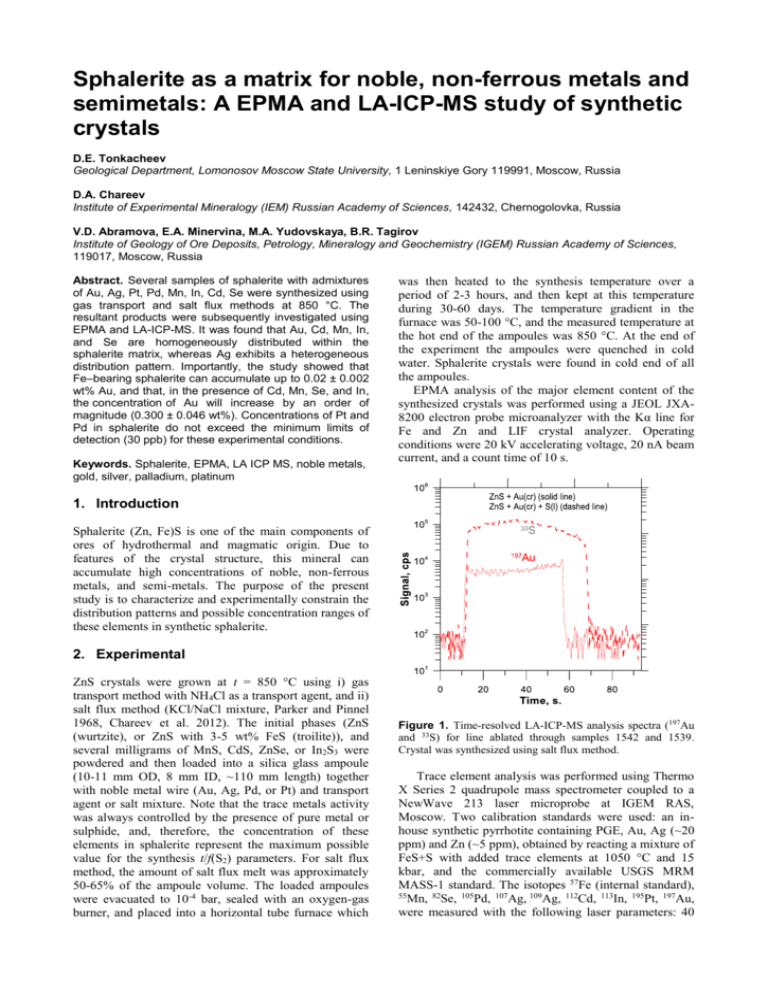
Sphalerite as a matrix for noble, non-ferrous metals and semimetals: A EPMA and LA-ICP-MS study of synthetic crystals D.E. Tonkacheev Geological Department, Lomonosov Moscow State University, 1 Leninskiye Gory 119991, Moscow, Russia D.A. Chareev Institute of Experimental Mineralogy (IEM) Russian Academy of Sciences, 142432, Chernogolovka, Russia V.D. Abramova, E.A. Minervina, M.A. Yudovskaya, B.R. Tagirov Institute of Geology of Ore Deposits, Petrology, Mineralogy and Geochemistry (IGEM) Russian Academy of Sciences, 119017, Moscow, Russia Abstract. Several samples of sphalerite with admixtures of Au, Ag, Pt, Pd, Mn, In, Cd, Se were synthesized using gas transport and salt flux methods at 850 °C. The resultant products were subsequently investigated using EPMA and LA-ICP-MS. It was found that Au, Cd, Mn, In, and Se are homogeneously distributed within the sphalerite matrix, whereas Ag exhibits a heterogeneous distribution pattern. Importantly, the study showed that Fe–bearing sphalerite can accumulate up to 0.02 ± 0.002 wt% Au, and that, in the presence of Cd, Mn, Se, and In, the concentration of Au will increase by an order of magnitude (0.300 ± 0.046 wt%). Concentrations of Pt and Pd in sphalerite do not exceed the minimum limits of detection (30 ppb) for these experimental conditions. Keywords. Sphalerite, EPMA, LA ICP MS, noble metals, gold, silver, palladium, platinum was then heated to the synthesis temperature over a period of 2-3 hours, and then kept at this temperature during 30-60 days. The temperature gradient in the furnace was 50-100 °C, and the measured temperature at the hot end of the ampoules was 850 °C. At the end of the experiment the ampoules were quenched in cold water. Sphalerite crystals were found in cold end of all the ampoules. EPMA analysis of the major element content of the synthesized crystals was performed using a JEOL JXA8200 electron probe microanalyzer with the Kα line for Fe and Zn and LIF crystal analyzer. Operating conditions were 20 kV accelerating voltage, 20 nA beam current, and a count time of 10 s. 1. Introduction Sphalerite (Zn, Fe)S is one of the main components of ores of hydrothermal and magmatic origin. Due to features of the crystal structure, this mineral can accumulate high concentrations of noble, non-ferrous metals, and semi-metals. The purpose of the present study is to characterize and experimentally constrain the distribution patterns and possible concentration ranges of these elements in synthetic sphalerite. 2. Experimental ZnS crystals were grown at t = 850 °C using i) gas transport method with NH4Cl as a transport agent, and ii) salt flux method (KCl/NaCl mixture, Parker and Pinnel 1968, Chareev et al. 2012). The initial phases (ZnS (wurtzite), or ZnS with 3-5 wt% FeS (troilite)), and several milligrams of MnS, CdS, ZnSe, or In2S3 were powdered and then loaded into a silica glass ampoule (10-11 mm OD, 8 mm ID, ~110 mm length) together with noble metal wire (Au, Ag, Pd, or Pt) and transport agent or salt mixture. Note that the trace metals activity was always controlled by the presence of pure metal or sulphide, and, therefore, the concentration of these elements in sphalerite represent the maximum possible value for the synthesis t/f(S2) parameters. For salt flux method, the amount of salt flux melt was approximately 50-65% of the ampoule volume. The loaded ampoules were evacuated to 10-4 bar, sealed with an oxygen-gas burner, and placed into a horizontal tube furnace which Figure 1. Time-resolved LA-ICP-MS analysis spectra (197Au and 33S) for line ablated through samples 1542 and 1539. Crystal was synthesized using salt flux method. Trace element analysis was performed using Thermo X Series 2 quadrupole mass spectrometer coupled to a NewWave 213 laser microprobe at IGEM RAS, Moscow. Two calibration standards were used: an inhouse synthetic pyrrhotite containing PGE, Au, Ag (~20 ppm) and Zn (~5 ppm), obtained by reacting a mixture of FeS+S with added trace elements at 1050 °C and 15 kbar, and the commercially available USGS MRM MASS-1 standard. The isotopes 57Fe (internal standard), 55 Mn, 82Se, 105Pd, 107Ag, 109Ag, 112Cd, 113In, 195Pt, 197Au, were measured with the following laser parameters: 40 μm beam size; 7-10 J/cm2 energy; and 10 Hz laser repetition rate. The sample was transferred to the mass spectrometer by helium flow (0.6 L/min), with an additional 6% H2. At the input to the mass spectrometer, helium was mixed with argon (0.8 L/min). Ablation was performed after 20 s measurement of the instrumental background. Concentrations of Pt and Pd in sphalerite were found to be below the minimum limit of detection of the LAICP-MS method (30 ppb). For other elements, EPMA yields the following concentration values (wt%): Mn = 0.761±0.035; Cd = 0.555±0.096; and Ag = 0.061±0.035. The second series of samples is a sphalerite with abundance of Fe up to 0.03 formula units (equivalent to 1.73 wt% Fe). The average gold content in the sample synthesized with an admixture of Au, as measured by LA-ICP-MS, is 234 ± 34 ppm. The distribution of gold is homogeneous. Another sphalerite with similar Fe content, this time with an admixture of Ag was found to contain 343 ± 86 ppm of trace metal. The distribution of Ag is heterogeneous. In the last sphalerite of this series, a number of distinct admixtures were simultaneously added. Concentrations (wt%, measured by EPMA) of Mn, In, Se, Cd and Au in the product were found to be 0.240 ± 0.020, 0.290 ± 0.011, 0.126 ± 0.040, 0.484 ± 0.060 and 0.300 ± 0.023, respectively (Fig. 1). Note that the last sample exhibits a tenfold increase in concentration of Au in comparison with pure (Zn,Fe)S. 4. Discussion Figure 2. Time-resolved LA-ICP-MS analysis spectra for line ablated through sample CD1450: top - 55Mn, 113In, 112Cd, 82Se, and 33S; bottom - 197Au and 33S. Crystal was synthesized using gas transport method. 3. Results Several different samples of sphalerite with various admixtures were synthesized. The first series of samples contained Fe-free sphalerite. LA-ICP-MS-analysis of the synthesized phases showed that the distribution patterns for Cd, Mn, and Au in ZnS are close to homogeneous. The concentration of Au in sphalerite was found to be an order of magnitude higher when excess sulphur was present in the ampoule (Au=111±50 ppm) than in the absence of sulphur (11±7 ppm; Fig. 1). This suggests that Au is chemically bound to S in the sphalerite matrix. Our study demonstrates that sphalerite can, at high temperatures, incorporate economically significant quantities of noble, non-ferrous metals, and semi-metals, including gold. In most cases these metals are homogeneously distributed within the host mineral matrix, which suggests that the trace elements are latticebound. In accord with the results of our study, significant concentration of Au can be incorporated into sphalerite in the ‘invisible’ state, especially at the temperature regimes of high-temperature magmatic-hydrothermal systems and volcanogenic massive sulphide deposits metamorphosed at granulite facies. Increase of sulphur fugacity, as well as activity of other trace components such as Cd, Mn, In, and Se, promotes the formation of Au-bearing sphalerite. At the same time, Pd and Pt are found to be incompatible with sphalerite. Another important outcome of our work is that sphalerite can retain Au in ‘invisible’ state after quenching. In contrast, Au-bearing Cu-Fe sulphides (bornite, chalcopyrite, intermediate solid solution) are not stable at low temperatures, and cooling of these minerals results in exsolution of metallic Au (c.f., Fraley and Frank 2012). Accordingly, in natural sulphide ores, the concentration of chemically bound ‘invisible’ Au in sphalerite can be higher than the concentration of Au which is homogeneously distributed within the matrix of coexisting Cu-Fe sulphides. Continuing work is being carried out to understand the effects of temperature, sulphur fugacity, and the presence of other elements on the distribution of noble and non-ferrous, and semi-metals in sphalerite. We will also address the chemical state of trace metals in synthesized phases using XAFS and/or XES spectroscopy. Acknowledgements Financial support for this study was provided by RSF (grant 14-17-00693). References Parker SG, Pinnell JE (1968) Molten flux growth cubic zinc sulfide crystals. J Cryst Growth 3-4:490-495 Chareev D, Osadchii E, Kuzmicheva T, Lin J-Y., Kusmichev S, Volkova O, Vasiliev A (2013). Single crystal growth and characterizarion of tetragonal FeSe1-x superconductors. Cryst Eng Comm 15:1989-1993 Fraley K.J., Frank M.R. (2014) Gold solubilities in bornite, intermediate solid solution, and pyrrhotite at 500° to 700°C and 100 MPa. Econ Geol 109:407-418
